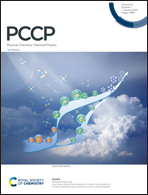Interplay of conformational relaxation and hydrogen bond dynamics in the excited states of fluorescent Schiff base anions†
Abstract
Time resolved fluorescence spectroscopic investigation of four Schiff base anions has established that their excited state dynamics is governed by several solvent properties: polarity, viscosity and hydrogen bond donating ability. With viscous protic solvents like glycerol, fluorescence lifetimes of anions have been found to be markedly longer than those in ethanol, implying that conformational relaxation of molecules plays a key role in their nonradiative relaxation. Surprisingly, the lifetimes in less viscous aprotic solvents, like acetonitrile, are found to be even longer. The only plausible rationalization of this observation is in the light of hydrogen bond-assisted nonradiative phenomena that are operative in protic solvents. This contention draws support from a time evolution of the emission in the red end of the spectrum in low to moderately hydrogen bond donating protic solvents, with regard to an absence of such a rise time in aprotic solvents and strongly hydrogen bond donating solvents, viz., 2,2,2-trifluoroethanol. Rudimentary quantum chemical calculations provide a preliminary idea about the nature of excited state hydrogen bond redistribution involved in the process.



 Please wait while we load your content...
Please wait while we load your content...